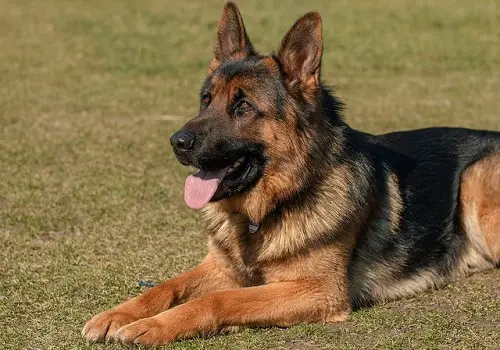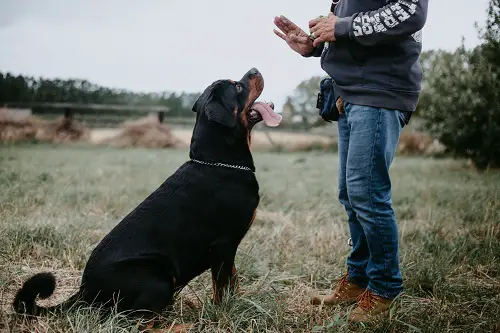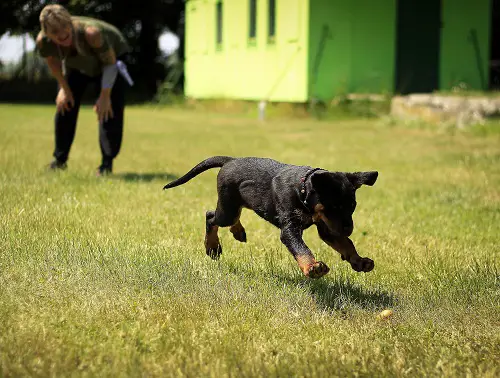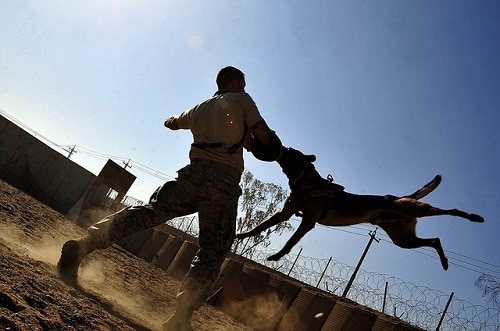Schutzhund is a sport that involves a lot of training and communication. Obedience is the first phase in IPO, so german dog commands might be a good place to start. It’s also essential because the handler must communicate effectively with the dog.
What Are Schutzhund Training Commands?
Schutzhund training commands are vocal cues used by handlers to tell their dogs what they have to do.
This sport has three parts: obedience, tracking, and protection. At each level, the dog must do exercises. Every phase will test different working skills. Thus, the handler needs to guide the dog with vocal commands through all of them.

Schutzhund Training Commands List (German Dog Commands)
German is the most common language used for Schutzhund. So you will probably have to train your dog with German commands to get into this sport. Here are all the terms you might have to learn in Schutzhund training with their pronunciation and English equivalent.
| Schutzhund Command (German) | Pronunciation | English Command |
|---|---|---|
| Achtung | Ahk-toong’ | Watch / Attention |
| Aus | Ows | Drop it / Let go |
| Bleib | Blibe | Stay |
| Bring | Brring | Fetch / Retrieve |
| Fass / Packen | Fahs | Attack / Take hold |
| Fuss | Foos | Heel |
| Gib Laut | Gib Lawt | Speak/Bark |
| Hier | Heer | Come |
| Hoop | Hup | Up / Jump |
| Nein | Nine | No |
| Pass Auf | Pahs owf | Pay attention / Watch / Guard |
| Pfui | Foo-ey | Shame / Stop that |
| Platz | Plots | Down |
| Sitzen/Sitz | Zeltz | Sit |
| Such | Zook | Search / Track |
| Voran/Revier | For-ahn / Ree-wiir | Go on (blind search) |
| Voraus | For-ows | Go out / Send out |
| Ruhig | Ruu-ich | Quiet |
| Zwinger | Tswi-nger | Kennel / Cage |
| Steh | Schtee | Stand |
| Lass es | Las es | Leave it |
| Brummen | Bru-men | Growl |
| Braver Hund / So ist Brav | Braa-wer Hunt / Zo ist Brav | Good dog |
| Nimm | Nim | Take it |
| Warten | War-ten | Wait |
| Pfote | Pfoo-te | Shake |
| Super | Zu-per | Good Job |
With all the German commands above, you should be able to start training your dog for Schutzhund. But now, you probably have many questions about those voice cues and how to use them. So let me share with you all that I know about Schutzhund training commands.
Pronunciation
Once you know the Schutzhund commands, it’s time to learn the appropriate pronunciation. First of all, hearing them said in a German way might be a good starting point. Then, you can slowly work your way up to sound like a professional protection dog trainer.
Pronouncing a command the right way isn’t essential. The most important is that you stay consistent in how you say it so your dog can associate the voice cue with a specific action. But learning pronunciation right off the bat could save you problems down the road.
Meaning
Although the meaning of a command and the word used for it might change from one trainer to another, it’s generally universal. Before introducing your dog to a new Schutzhund command, you should know the intent and action required behind the German voice cue.
Even with the English equivalent, it may still not be easy to understand what it means and when to use it. So here are more details about each Schutzhund training command!
| Schutzhund Command (German) | English Translation | Meaning |
|---|---|---|
| Achtung | Watch / Attention | This command tells your dog to stop what he’s doing and pay attention. |
| Aus | Drop it / Let go | This command tells your dog to let go of something or drop it. |
| Bleib | Stay | This command tells your dog to stop moving and hold his position. |
| Bring | Fetch / Retrieve | This command tells your dog to go fetch something and retrieve it. |
| Fass / Packen | Attack / Take hold | This command tells your dog to attack or take hold on the bite sleeve/suit. |
| Fuss | Heel | This command tells your dog to walk beside you. |
| Gib Laut | Speak/Bark | This command tells your dog to bark. |
| Hier | Come | This command tells your dog to come to you. |
| Hoop | Up / Jump | This command tells your dog to jump over something. |
| Nein | No | This command tells your dog to not do something before it happens or stop doing it immediately.. (Corrective Word) |
| Pass Auf | Pay attention / Watch / Guard | This command tells your dog to look at you and wait for the next command. |
| Pfui | Shame / Stop that | This command tells your dog to stop what he’s doing because it’s wrong. (Corrective Word) |
| Platz | Down | This command tells your dog to go in a down position. |
| Sitzen/Sitz | Sit | This command tells your dog to sit. |
| Such | Search / Track | This command tells your dog to find, search, or track something. |
| Voran/Revier | Go on (blind search) | This command tells your dog to start the blind search. |
| Voraus | Go out / Send out | This command tells your dog to take off in a dead run, straight in the direction you pointed. |
| Ruhig | Quiet | This command tells your dog to stop barking, growling, or making sounds. |
| Zwinger | Kennel / Cage | This command tells your dog to go to his kennel or cage. |
| Steh | Stand | This command tells your dog to go in a stand position. |
| Lass es | Leave it | This command tells your dog to ignore or not touch something. |
| Brummen | Growl | This command tells your dog to growl. |
| Braver Hund/So ist Brav | Good dog | This command tells your dog he behaved well or has done something right. (Praise Word) |
| Nimm | Take it | This command gives your dog permission to take, hold, or eat something he’s interested in. |
| Warten | Wait | This command tells your dog to focus on you, not move, and wait. |
| Pfote | Shake | This command tells your dog to give you his paw and shake hands. |
| Super | Good Job | This command tells your dog that what he does is good and properly done. (Praise Word) |
What Are The Basic Schutzhund Commands?
With all the German commands on the list, starting Schutzhund training might seem overwhelming. But don’t worry, it’s not necessary to learn all of them right away. You can begin with the basic commands and slowly improve your dog’s obedience from there.

Depending on your goals and the trainer you work with, there might be different ways to get started. But in general, basic Schutzhund commands will allow you to have more control over your dog and communicate with him effectively.
Here are the German commands you should learn as soon as possible.
| Schutzhund Command (German) | Pronunciation | English Command | Meaning |
|---|---|---|---|
| Pass Auf | Pahs owf | Pay attention! / Watch! | This command tells your dog to look at you and wait for the next command. |
| Fuss | Foos | Heel | This command tells your dog to walk beside you. |
| Sitzen/Sitz | Zeltz | Sit | This command tells your dog to sit. |
| Platz | Plots | Down | This command tells your dog to go in a down position. |
Apart from those 4 essential Schutzhund commands, you can also add a praise and correction word. So “Super or So Brav” and “Pfui” could be two voice cues to teach your dog right from the start. Then, you will learn other commands as you need them for training.
Why Are Schutzhund Training Commands In German?
They developed Schutzhund many years ago in Germany as a breed test for German Shepherds. Now it’s a sport where the dog has to improve and show his obedience, tracking, and protection skills. But is there any reason why most trainers still use German commands or is it just a tradition?
Some people say German is more defined and clear for dogs to learn. Others think the language doesn’t matter as long as you’re consistent. You might also want to use German in Schutzhund because it generally travels better over long distances than English.
Then, you might want or have to follow the lead. Most trainers use German commands. So if your local club or mentor uses this language, you will probably do the same. That’s why most people still do Schutzhund training in German.
Do You Have To Use German Commands For Schutzhund?
Using German commands for Schutzhund isn’t mandatory. It’s just common practice. You can use any language during a BH or IPO trial as long as you use the same the whole time. So learning German commands isn’t necessary if you want to use another language for Schutzhund training.
However, the concept of informal and formal commands might be interesting. Some handlers use German for formal Schutzhund training only. Then, they use another language for more informal commands. There are two main advantages of using this method.
First, it will allow your family and friends to use their native language while communicating with the dog. Besides that, your dog will understand it’s time to work and focus if you use German commands. So using two languages, one for Schutzhund and one for the day-to-day, might be an excellent idea.
Schutzhund Commands In Different Languages!
English and German aren’t the only two languages you can use for Schutzhund. You might also train your dog with French, Czech, or Dutch commands. So here are the voice cues used for this sport in 5 different languages.
| German | English | French | Czech | Dutch |
|---|---|---|---|---|
| Achtung | Watch / Attention | Regarde-moi / Fixe | Hodinky / Pozornost | Kijk Maar / Aandacht |
| Aus | Drop it / Let go | Lache / Donne | Pust | Los / Loslaten |
| Bleib | Stay | Reste | Zustan | Blijf |
| Bring | Fetch / Retrieve | Va chercher / Rapporte | Aport | Apport |
| Fass / Packen | Attack / Take hold | Attaque / Mord | Drz | Stellen |
| Fuss | Heel | Au pied | K noze | Left: VolgRight: Rechts |
| Gib Laut | Speak/Bark | Parle / Aboie | Stekej | Blaffen / Luid |
| Hier | Come | Viens / Ici | Kemne | Hier |
| Hoop | Up / Jump | Saute | Skoc / Hop | Over |
| Nein | No | Non | Ne | Nee |
| Pass Auf | Pay attention / Watch / Guard | Garde | Pozor | Bewaken |
| Pfui | Shame / Stop that | Mauvais / Arrête | Fuj | Foei |
| Platz | Down | Coucher | Lehni | Af / Liggen |
| Sitzen/Sitz | Sit | Assis | Sedni | Zit |
| Such | Search / Track | Piste | Stopa | Keuring / Zock |
| Voran/Revier | Go on (blind search) | Cherche | Revir | Revieren |
| Voraus | Go out / Send out | Vas / En avant | Volno | Voor uit / Vrij |
| Ruhig | Quiet | Silence | Klid | Stil |
| Zwinger | Kennel / Cage | Chenil / Cage | Kotec | Hok / Kennel |
| Steh | Stand | Debout | Stuj | Staan |
| Lass es | Leave it | Laisse / Pas touche | Nech to | Los |
| Brummen | Growl | Grogne | Zavrčení | Grommen |
| Braver Hund/So ist Brav | Good dog | Bon chien | Hodny | Braaf / Goedzo |
| Nimm | Take it | Prends-le | Vzít | Nemen |
| Warten | Wait | Attends | Počkejte | Wacht |
| Pfote | Shake | Donne la patte | Tlapka | Poot |
| Super | Good Job | Bravo / Bon travail | Báječné | Super |
How To Teach Your Dog Schutzhund Commands?
Now that you know what the Schutzhund training commands are, it’s time for your dog to learn them too. The ultimate goal is to associate a voice cue with the desired action. So regardless of the language you use, teaching commands to a dog is the same process. Just make sure your dog is ready to get started!
Find Out More About When To Start Training Your Dog For Schutzhund!

Use Positive Reinforcement.
As with any other type of training, positive reinforcement is generally the way to go. It consists of giving a reward to your dog when he does something properly. So you will encourage him to do the desired action and reward good behavior for reinforcement.
Reward.
The reward should be something your dog likes and motivates him to improve his skills. In general, we are talking about high-value treats, his favorite toy, some playtime, or even praise. As long as it’s enjoyable and encouraging for your dog, the reward can be anything.
Switch From English Commands To German.
If your dog already knows the basic commands in English, you don’t have to start over again. You can use this knowledge to your advantage. Switching from English commands to German ones for Schutzhund isn’t that complicated.
You can start by adding the German command after the English one while rewarding your dog. Then, you can slowly drop the English version during Schutzhund training.
Over time, your dog should be able to understand both languages. Just make sure to work on one command at a time and not overdo it.
Hand Signals.
Once your dog master commands with voice cues, you could add hand signals to the mix. Speaking isn’t the only way to communicate together. Dogs can also respond to what they see. Thus, body positions and hand signals might reinforce the desired action.
It’s also a convenient and effective way to keep control in an environment where your dog can’t hear you or in a situation where you can speak. Learning the commands with hand signals will make him a better and more versatile protection dog.
Join a Club.
Finding a local Schutzhund club that suits your needs and goals can also help you get started. There’s nothing better than a community of experienced protection dog trainers to guide you in the training process. It’s ideal for beginners to learn Schutzhund commands.
Trainer.
Apart from joining a club, you can also pay a professional trainer to assist and help you. They will give you all their attention and provide you with personalized feedback. So it’s the best solution to introduce your dog to Schutzhund commands quickly and effectively.
See How Long Schutzhund Training Can Take!
Last Thoughts About Schutzhund Training Commands!
Finally, there are many commands you have to learn for Schutzhund training. Whether you teach them to your dog in German, English, or any other language, it’s essential to be consistent. Voice cues will allow you to have more control over your companion.
You don’t have to learn all the Schutzhund commands right off the bat. Working on the basic ones such as Fuss (Heel), Sitz (Sit), and Platz (Down) is more than enough to get started. Then, you will slowly have to improve your dog’s obedience to win the BH and IPO titles.

So what are you waiting for? Learning Schutzhund commands is only one step in the process of training your dog for this sport. Starting now only makes you closer to your ultimate goal, whether it’s having a better companion or participating in a trial.
Have Fun Teaching Schutzhund Commands To Your Dog!